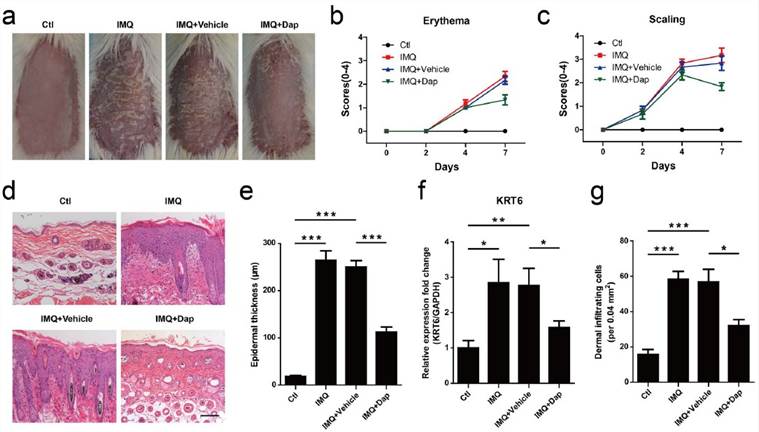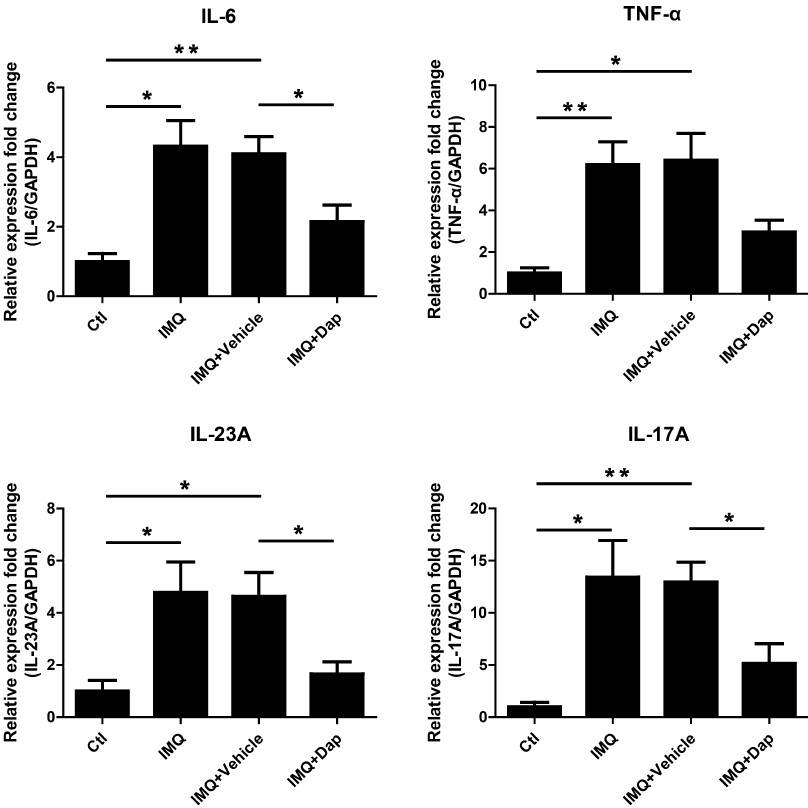- You are here: Home
- Disease Models
- Inflammation & Autoimmune Disease Models
- Psoriasis Model
- Imiquimod (IMQ)-Induced Psoriasis Model
Disease Models
- Oncology Models
-
Inflammation & Autoimmune Disease Models
- Rheumatoid Arthritis Models
- Glomerulonephritis Models
- Multiple Sclerosis (MS) Models
- Ocular Inflammation Models
- Sjögren's Syndrome Model
- LPS-induced Acute Lung Injury Model
- Peritonitis Models
- Passive Cutaneous Anaphylaxis Model
- Delayed-Type Hypersensitivity (DTH) Models
- Inflammatory Bowel Disease Models
- Systemic Lupus Erythematosus Animal Models
- Asthma Model
- Sepsis Model
- Psoriasis Model
- Atopic Dermatitis (AD) Model
- Scleroderma Model
- Gouty Arthritis Model
- Carrageenan-Induced Air Pouch Synovitis Model
- Carrageenan-Induced Paw Edema Model
- Experimental Autoimmune Myasthenia Gravis (EAMG) Model
-
Cardiovascular Disease Models
- Surgical Models
- Animal Models of Hypertension
- Venous Thrombosis Model
- Atherosclerosis model
- Cardiac Arrhythmia Model
- Hyperlipoidemia Model
- Doxorubicin-induced Heart Failure Model
- Isoproterenol-induced Heart Failure Model
- Arterial Thrombosis Model
- Pulmonary Arterial Hypertension (PAH) Models
- Heart Failure with Preserved Ejection Fraction (HFpEF) Model
-
Neurological Disease Models
- Alzheimer's Disease Modeling and Assays
- Seizure Models
- Parkinson's Disease Models
- Ischemic Stroke Models
- Acute Spinal Cord Injury (ASCI) Model
- Traumatic Brain Injury (TBI) Model
- Hypoxic-Ischemic Encephalopathy (HIE) Model
- Tourette Syndrome (TS) Model
- Amyotrophic Lateral Sclerosis (ALS) Model
- Huntington's Disease (HD) Model
- Intracerebral hemorrhage (ICH) Models
- Pain Models
- Metabolic Disease Models
- Liver Disease Models
- Rare Disease Models
- Respiratory Disease Models
- Digestive Disease Models
-
Urology Disease Models
- Cisplatin-induced Nephrotoxicity Model
- Unilateral Ureteral Obstruction Model
- 5/6 Nephrectomy Model
- Renal Ischemia-Reperfusion Injury (RIRI) Model
- Diabetic Nephropathy (DN) Models
- Passive Heymann Nephritis (PHN) Model
- Adenine-Induced Chronic Kidney Disease (CKD) Model
- Kidney Stone Model
- Doxorubicin-Induced Nephropathy Model
- Orthopedic Disease Models
- Ocular Disease Models
- Skin Disease Models
- Infectious Disease Models
Imiquimod (IMQ)-Induced Psoriasis Model
Creative Bioarray, with our profound scientific research capabilities and unique innovative concepts, provides excellent animal model services to the scientific community, especially in the field of imiquimod (IMQ)-induced psoriasis model. We promise to provide efficient and professional services throughout the entire process, from model establishment and validation to data collection and analysis, to ensure the smooth progress of your research. Therefore, if you are looking for a stable, reliable, and efficient IMQ-induced psoriasis model, Creative Bioarray is your best choice.
The IMQ-induced psoriasis model stands as the most widely utilized preclinical model in the psoriasis research. IMQ, a potent immune activator and agonist of Toll-like receptors (TLR7/8), triggers a range of pathophysiological responses when administered. These include erythema, scaling, keratinocyte proliferation and differentiation, as well as dermal T-cell infiltrations. These phenomena mimic the characteristic clinical features observed in human psoriatic lesions. Moreover, the disease development in this model is often accompanied by an enlargement of the spleen, reflecting the systemic immune activation that occurs in psoriasis. This model not only recapitulates the cutaneous manifestations of psoriasis but also recapitulates the underlying immunological processes, providing a robust platform for investigating the pathogenesis of the disease and evaluating potential therapeutic agents.
Our Imiquimod (IMQ)-Induced Psoriasis Model
- Available Animal
Rat
Mouse - Modeling Method
At Creative Bioarray, IMQ cream is applied to the shaved skin on the back to induce psoriasis model. - Endpoints
- Clinical score
- Clinical observation
- Histology analysis: H&E staining
- Body weight
- Epidermal thickness
- Cytokine analysis
- Other customized endpoints: available upon request
Example Data
 Fig. 1 The effect of daphnetin on skin lesion in IMQ-induced psoriasis-like mouse model. (a) The macroscopic appearance of mouse back skin on day 8. (b) Erythema and (c) scaling was scored on days 0, 2, 4, and 7 based on the PASI. (d) H&E staining of the mouse skin. (e) Epidermal thickness was calculated by Image-pro Plus 6.0 software. (f) qRT-PCR was performed to measure the expression of KRT6 in skin lesion. GAPDH served as an internal reference. (g) Dermal cellular infiltrates were quantitated with H&E staining images.
Fig. 1 The effect of daphnetin on skin lesion in IMQ-induced psoriasis-like mouse model. (a) The macroscopic appearance of mouse back skin on day 8. (b) Erythema and (c) scaling was scored on days 0, 2, 4, and 7 based on the PASI. (d) H&E staining of the mouse skin. (e) Epidermal thickness was calculated by Image-pro Plus 6.0 software. (f) qRT-PCR was performed to measure the expression of KRT6 in skin lesion. GAPDH served as an internal reference. (g) Dermal cellular infiltrates were quantitated with H&E staining images.
 Fig. 2 The effect of daphnetin on the expression of inflammatory cytokines in IMQ-induced psoriasis-like skin lesion. qRT-PCR was performed to measure the expression of IL-6, TNF-α, IL-23A and IL-17A in skin lesion. GAPDH served as an internal reference.
Fig. 2 The effect of daphnetin on the expression of inflammatory cytokines in IMQ-induced psoriasis-like skin lesion. qRT-PCR was performed to measure the expression of IL-6, TNF-α, IL-23A and IL-17A in skin lesion. GAPDH served as an internal reference.
Meanwhile, we also provide another psoriasis model that maybe you are interested in:
Quotation and Ordering
Creative Bioarray boasts a team of talented experts and scientists specializing in creating inflammation models, selecting models, and conducting preclinical experiments. We are committed to sharing our cutting-edge technology and extensive expertise to support our clients' research and enhance its impact.
Reference
- Gao, J., et al. Daphnetin inhibits proliferation and inflammatory response in human HaCaT keratinocytes and ameliorates imiquimod-induced psoriasis-like skin lesion in mice. Biol Res, 2020, 20;53(1):48.
For research use only. Not for any other purpose.

